
The Royal Armoured Corps is the armoured arm of the British Army, that together with the Household Cavalry provides its armour capability, with vehicles such as the Challenger 2 and the Warrior tracked armoured vehicle. It includes most of the Army's armoured regiments, both the Royal Tank Regiment and those converted from old horse cavalry regiments. Today it comprises twelve regiments, eight regular and four Army Reserve. Although the Household Cavalry Regiment provide an armoured regiment, they are not part of the RAC.
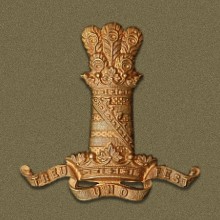
The 11th Hussars (Prince Albert's Own) was a cavalry regiment of the British Army established in 1715. It saw service for three centuries including the First World War and Second World War but then amalgamated with the 10th Royal Hussars (Prince of Wales' Own) to form the Royal Hussars in 1969.
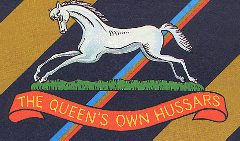
The Queen's Own Hussars (QOH), was a cavalry regiment of the British Army, formed from the amalgamation of the 3rd The King's Own Hussars and the 7th Queen's Own Hussars at Candahar Barracks, Tidworth in 1958. The regiment served in Aden and Northern Ireland and as part of the British Army of the Rhine. The regiment was amalgamated with the Queen's Royal Irish Hussars to form the Queen's Royal Hussars on 1 September 1993.

The Queen's Royal Irish Hussars, abbreviated as QRIH, was a cavalry regiment of the British Army formed from the amalgamation of the 4th Queen's Own Hussars and the 8th King's Royal Irish Hussars in 1958. The regiment saw active service against insurgents in Aden; during the Indonesia–Malaysia confrontation and during the Gulf War, as well as regular service in West Germany as part of the British Army of the Rhine. The regiment was amalgamated with the Queen's Own Hussars to form the Queen's Royal Hussars on 1 September 1993.

The Queen's Royal Hussars (The Queen's Own and Royal Irish) (QRH) is a British armoured regiment. It was formed on 1 September 1993 from the amalgamation of the Queen's Own Hussars and the Queen's Royal Irish Hussars. The regiment and its antecedents have been awarded 172 Battle Honours and eight Victoria Crosses. The regiment was based in Sennelager, Germany, until 2019 when it was relocated to Tidworth Camp, England. It is the armoured regiment for 20th Armoured Brigade Combat Team.

The Prince of Wales's Own Regiment of Yorkshire was an infantry regiment of the British Army, part of the King's Division. It was created in 1958 by the amalgamation of the West Yorkshire Regiment and the East Yorkshire Regiment. After 48 years service, the regiment was amalgamated again, this time with two other Yorkshire regiments. It became the 1st Battalion of the Yorkshire Regiment, with the Green Howards forming the 2nd Battalion and the Duke of Wellington's Regiment forming the 3rd Battalion on 6 June 2006. Following further merges, in 2012, the battalion was redesignated as the new 2nd Battalion (2Yorks).

The Cheshire Regiment was a line infantry regiment of the British Army, part of the Prince of Wales' Division. The 22nd Regiment of Foot was raised by the Henry Howard, 7th Duke of Norfolk in 1689 and was able to boast an independent existence of over 300 years. The regiment was expanded in 1881 as part of the Childers Reforms by the linking of the 22nd (Cheshire) Regiment of Foot and the militia and rifle volunteers of Cheshire. The title 22nd (Cheshire) Regiment continued to be used within the regiment.
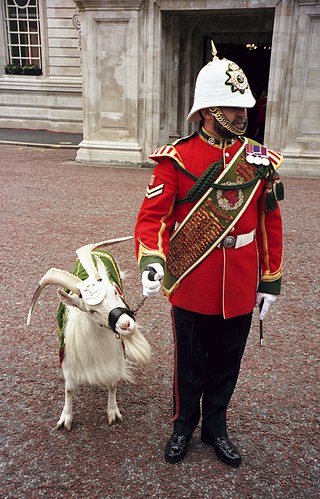
The Royal Regiment of Wales was an infantry regiment of the British Army, part of the Prince of Wales' Division. It was formed in 1969 by the amalgamation of the South Wales Borderers and the Welch Regiment. The 1st Battalion, The Royal Regiment of Wales had a short existence in military terms, just over 36 years. Within two months of amalgamation, the battalion was one of the first units to be deployed to Northern Ireland.
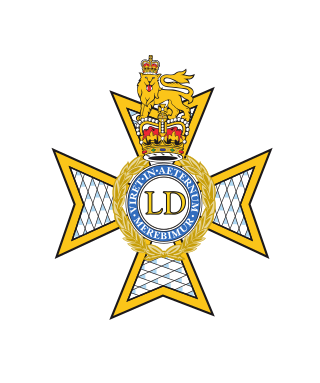
The Light Dragoons (LD) is a cavalry regiment in the British Army. The regiment has a light cavalry role and specialises in mounted and dismounted reconnaissance. The Light Dragoons recruit mainly in Northern England, from County Durham, Northumberland, Tyne and Wear, South Yorkshire and the East Riding of Yorkshire. For this reason, the regiment is known as "England's Northern Cavalry". It is currently based in Catterick Garrison, North Yorkshire.

The King's Royal Hussars (KRH) is a Royal Armoured Corps regiment of the British Army formed in 1992. Based at Tidworth it serves as the armoured regiment of the 12th Armoured Brigade Combat Team (ABCT). Under Army 2020 Refine, it is intended to exchange its Challenger 2 tanks for Ajax vehicles.
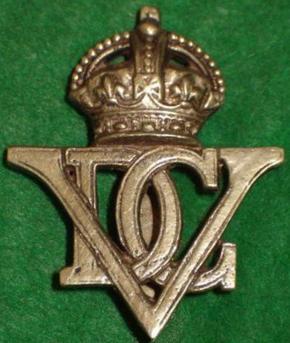
The 5th Royal Inniskilling Dragoon Guards was a cavalry regiment of the British Army formed in 1922 by the amalgamation of the 5th Dragoon Guards and the 6th (Inniskilling) Dragoons. It served in the Second World War and the Korean War. In August 1992, as a consequence of the Options for Change defence cuts, the regiment was amalgamated with the 4th/7th Royal Dragoon Guards to form the Royal Dragoon Guards.

The 15th/19th The King's Royal Hussars was a cavalry regiment of the British Army. The regiment was formed by the amalgamation of the 15th The King's Hussars and the 19th Royal Hussars in 1922 and, after service in the Second World War, it was amalgamated with the 13th/18th Royal Hussars to form the Light Dragoons in 1992.

The 13th/18th Royal Hussars was a cavalry regiment of the British Army. It was formed by the amalgamation of the 13th Hussars and the 18th Royal Hussars in 1922 and, after service in the Second World War, it amalgamated with the 15th/19th The King's Royal Hussars to form the Light Dragoons in 1992.

The 4th/7th Royal Dragoon Guards was a cavalry regiment of the British Army formed in 1922. It served in the Second World War. However following the reduction of forces at the end of the Cold War and proposals contained in the Options for Change paper, the regiment was amalgamated with the 5th Royal Inniskilling Dragoon Guards, to form the new Royal Dragoon Guards in 1992.

The 17th/21st Lancers was a cavalry regiment of the British Army. It was formed in England by the amalgamation of the 17th Lancers and the 21st Lancers in 1922 and, after service in the Second World War, it amalgamated with the 16th/5th The Queen's Royal Lancers to form the Queen's Royal Lancers in 1993.

The 10th Royal Hussars (Prince of Wales's Own) was a cavalry regiment of the British Army raised in 1715. It saw service for three centuries including the First World War and Second World War but then amalgamated with the 11th Hussars (Prince Albert's Own) to form the Royal Hussars (Prince of Wales's Own) in October 1969.

The 14th/20th King's Hussars was a cavalry regiment of the British Army. It was created by the amalgamation of the 14th King's Hussars and the 20th Hussars in 1922 and, after service in the Second World War, it amalgamated with the Royal Hussars to become the King's Royal Hussars in 1992.
The 16th/5th The Queen's Royal Lancers was a cavalry regiment of the British Army. It was formed by the amalgamation of the 16th The Queen's Lancers and the 5th Royal Irish Lancers in 1922. The reason for the uniquely atypical regimental title was that the 5th had been re-raised in 1858 almost 60 years after being disbanded, and when re-raised took precedence after the 17th Lancers. After service in the Second World War and the Gulf War, the regiment amalgamated with the 17th/21st Lancers to form the Queen's Royal Lancers in 1993.

The 7th Queen's Own Hussars was a cavalry regiment in the British Army, first formed in 1689. It saw service for three centuries, including the First World War and the Second World War. The regiment survived the immediate post-war reduction in forces, but following the 1957 Defence White Paper, it was amalgamated with the 3rd The King's Own Hussars, forming the Queen's Own Hussars in 1958.

Barker Barracks was a military installation in Paderborn, Germany.



















